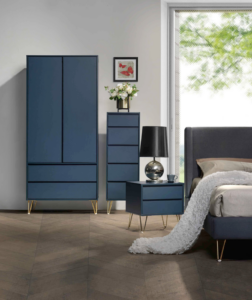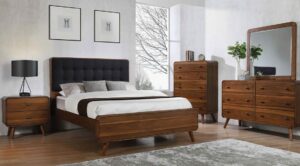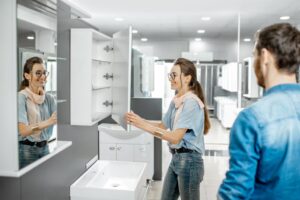The US furniture industry is a significant contributor to the domestic retail economy, with an estimated 2021 value of $115.6 billion. The average order value (AOV) for furniture purchases in the US is around $1,387, with shoppers buying an average of 6.8 pieces per transaction; yet, while 80% of Americans are willing to purchase home accents online, many remain hesitant to purchase large furniture items that way (Statista). Even better for vendors, the experience of physically interacting with furniture and décor can inspire shoppers to make purchases they may not have considered before. An in-person furniture store visit often results in shoppers buying more than they intended, with over 70% of shoppers reporting impulse purchases, according to Furniture Today. To get a better understanding of how critical brick-and-mortar remains to furniture retailers, let’s take a look at two hypothetical, but entirely typical store visits. First, our imaginary customer visits Furniture Store #1.
A Tale of Two Companies
Furniture Company #1 does things the old-fashioned way. When customers come into one of their brick-and-mortar stores, a rep greets them with no data about their taste, budget, or preference and has no way to access that data except with a series of questions. Her commission is based only on in-store sales and she trails the customers closely throughout the store, aggressively peppering them for information and trying to sell them things they don’t like and can’t afford. They’re put off and leave empty-handed. The lack of personalization and gracious customer service leads to lost revenue and, later, to a negative online review.
The problem is that Company #1’s approach to sales is outdated and unhelpful to the customer. Because the business has failed to gather or leverage any information in advance of the visit, the sales representative is not able to provide personalized recommendations or guide them to furniture that they would actually want and be able to afford. Instead, the representative’s sole focus is on making a sale, which offends the shoppers. This approach to sales creates a frustrating experience for them, as they feel unheard and undervalued. Clearly, store #1 needs to update its sales strategy to better cater to the needs and preferences of its customers to succeed in the competitive furniture retail market.
On the other hand, Furniture Company #2 has invested time, energy, and resources into creating the omnichannel customer experience that today’s shoppers demand. Data has been gathered and is ready to be employed. When the shoppers come into the store, any available rep can access their file with just a name or email address and immediately grasp their tastes, preferences, budget, and browsing history. The rep has been assured that, if the shoppers go on to complete their transaction online, her compensation will reflect her participation in the sale, so there’s no pressure. She hangs back and answers their questions, shows them a lamp that goes with the suite they’re considering, and thanks them for visiting when they leave empty-handed. The visitors have a leisurely and positive experience in the store, go home, make their purchase, impulsively add that lamp and a rug to their ticket, and leave a great review on social media after delivery.
Company #2’s customer experience is a great example of how retailers can use data and technology to provide personalized service and create a positive shopping experience that meets consumers where they are, builds a relationship with them, and guides them to where they want to go. Using information that has been gathered at each touch point, the sales representative is able to provide tailored recommendations that meet her visitors’ specific needs. She can focus on helping, not selling. The company’s understanding that some customers may choose to complete their purchases online shows that they are willing to adapt to changing consumer behavior and create a seamless shopping experience across multiple channels.
This customer-centric approach to sales creates a relaxed environment that allows shoppers to explore the store and consider their options without feeling rushed or pushed towards specific products. Shoptelligence CEO Laura Khoury says, “Consumers want sales associates to answer questions that they can’t answer themselves, questions that are unique to their situation. Helping sales associates engage in a more personalized way will not only increase close rates but also deliver a more valuable customer experience, enhancing profit and loyalty.” The ability to look up the shoppers’ browsing history and preferences empowers and supports the associate, increasing the likelihood of a successful sale. By creating a positive and hassle-free experience, Company #2 has set itself apart from competitors and created a loyal customer base that will drive sales and growth in the long term.
Better In-Store Experiences Build Longer Relationships
By providing a great in-store experience, Company #2 not only generates revenue but also creates loyal customers who are likely to return the next time they are in the market for a piece of furniture. In contrast to Company #1, Company #2’s approach reflects their understanding that personalization and exceptional customer service are key to ongoing success in the competitive furniture retail market. The customer loyalty and repeat business that Company #2 is prioritizing are critical to the success of furniture retailers. According to a study by Bain & Company, “Across a wide range of businesses, customers generate increasing profits each year they stay with a company.” Repeat customers are also more likely to spend more money and make larger purchases than new customers. Another Bain & Company study concluded that the average repeat customer spends 67% more in months 31-36 of their relationship with a business than they do in months 0-6.
For furniture retailers, building customer loyalty is particularly important because what they’re selling is a high-consideration purchase that often involves significant investment. A loyal customer base can help furniture retailers weather economic downturns, as customers who have built a relationship with the store are more likely to continue making purchases even in challenging times. Repeat customers are also more likely to refer friends and family to the store, helping to drive new business. In addition to the financial benefits, customer loyalty also creates a positive brand reputation and can help to differentiate the store from competitors. By providing exceptional customer service and personalized experiences, furniture retailers can build relationships with customers that go beyond the transactional. This can help to create a sense of loyalty and trust that will keep customers coming back for years to come.
Converting Online Data into In-Store Sales
Shoptelligence supports furniture retailers as they leverage online data to improve customers’ in-store experience. Our platform captures every interaction of each consumer automatically, learning their preferences to create and store a unique and portable omnichannel STyle Profile which can be accessed at every point on the path to purchase. When a customer identifies themself to an associate, that representative then has all the information and tools they need to provide an attentive experience. They can use it to skillfully blend personalization with personal assistance, delighting the consumer and leading to conversion.
Analyzing your customers’ online data can also influence brick-and-mortar sales by guiding decisions about staff training and customer service. For example, when the data shows that the store’s typical customer values a high level of personalization (and it will!), your business can invest in training sales staff to weave that website data into the kind of low-pressure in-store experience that today’s customers demand. Additionally, data from surveys can be used to track in-store behavior, such as which products are being browsed or how long shoppers spend in certain areas of the store. This information can be used to optimize the store layout and product placement to improve the overall in-store experience.
Creating an In-Store Experiences that Delights with Shoptelligence
Successful furniture brands are gathering and applying the omnichannel online data they need to provide the in-store experiences customers crave with Shoptelligence, a discreet, under-the-hood platform that is easily and quickly installed on your existing website. The AI-powered engine gathers the client data that your associates need to deliver the best, most personalized and successful in-store shopping experiences. Merchants using Shoptelligence see results:
- 6x increase in time on site
- 30x boost in site-to store revenue
- 42% lift in average order size
- 33% increase in revenue per buyer
What could Shoptelligence do for your retail business? Schedule a product tour today and let’s explore the possibilities together.






